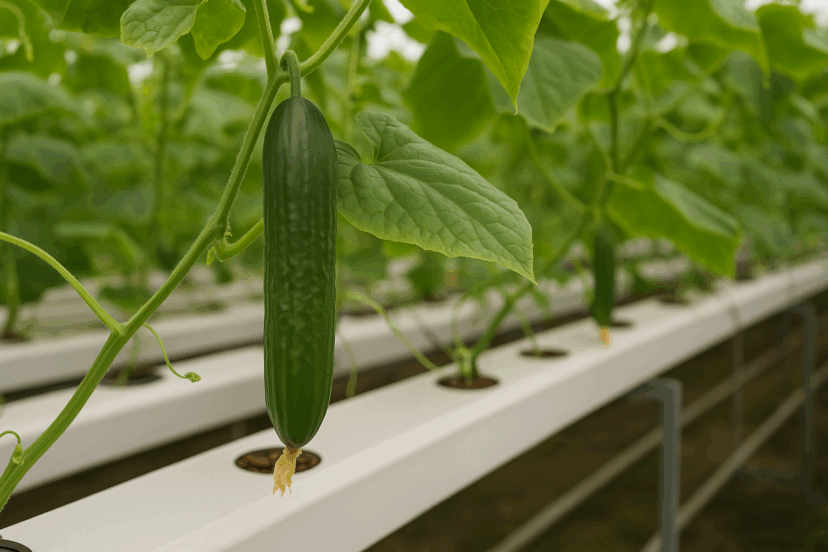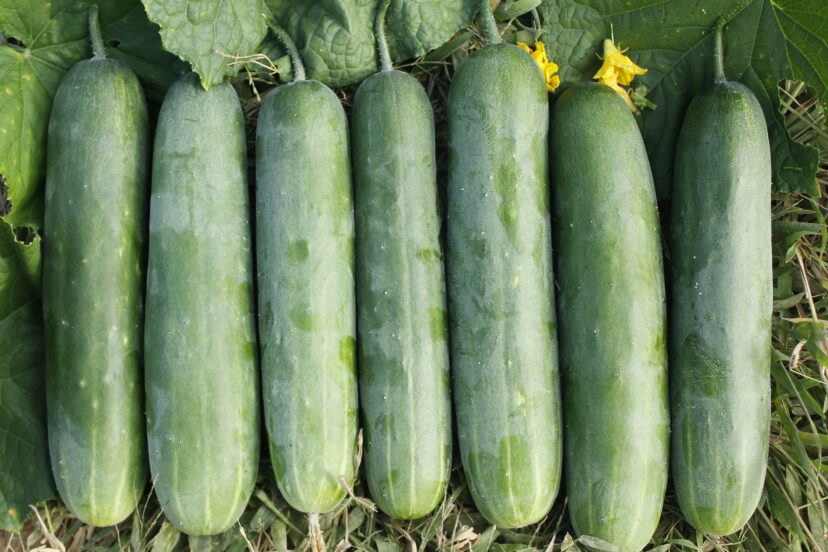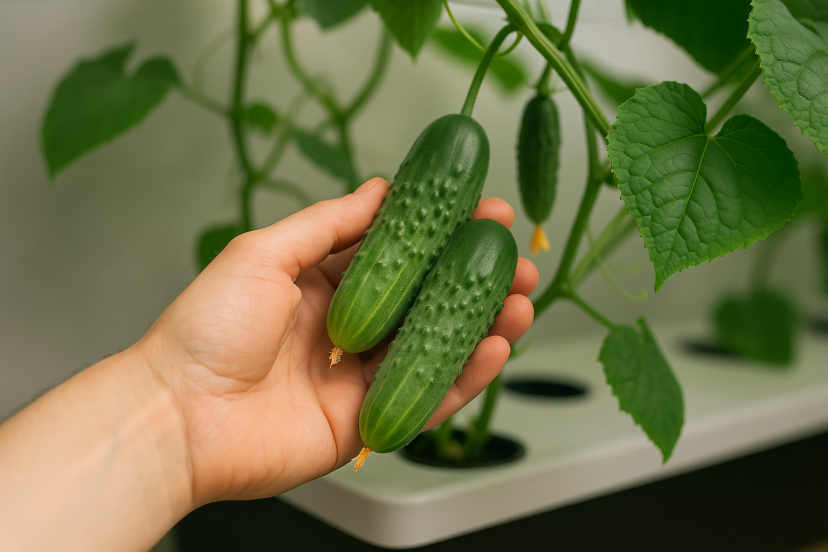Hydroponic Cucumbers: The Ultimate Gardener’s Guide
We may earn a commission for purchases made using our links. Please see our disclosure for more details.
Buying cucumbers from the store can feel disappointing. They’re not always fresh and spoil too fast. Growing them in soil outside is tricky too. Pests, weeds, and bad weather can ruin your hard work overnight. That’s why so many gardeners switch to hydroponic cucumbers. You don’t need dirt or big garden space. You control the light, water, and nutrients. The result? Fresh, crisp cucumbers all year, right at home. In this guide, you’ll learn step by step how to grow hydroponic cucumbers indoors and enjoy juicy harvests whenever you want.
Why Hydroponic Cucumbers?
People’s perspectives on food production are changing thanks to hydroponic gardening. Cucumbers are a vegetable that thrives in a soil-less environment.
Cucumbers prefer moisture and steady nutrients, which hydroponics provides in abundance. You’ll also have less pests and diseases to deal with, leaving you more time to appreciate the pleasant aspects of gardening, such as training vines, watching fruits develop, and appreciating the crunch in your salads.
Understanding the Hydroponic Advantage
So, what makes hydroponic cucumbers so rewarding? Here’s what gardeners love most:
Consistent growth: The roots have constant access to nutrients and water, so plants don’t experience the stress they might in soil.
No soil-borne diseases: Fusarium wilt, powdery mildew, and other nasties that lurk in dirt are far less of a problem.
Bigger harvests: With the right care, you can get more cucumbers per plant and harvest multiple times a year—indoors or out.
Space-saving: Vertical trellising lets you grow more in small spaces like balconies, garages, or basements.
Cleaner produce: No more scrubbing dirt off your cucumbers!

Best Hydroponic Systems for Cucumbers
Choosing the right hydroponic system is key to growing strong, healthy cucumbers indoors. Different setups work better for different spaces, budgets, and experience levels. Here are three popular hydroponic setups that gardeners love for cucumbers:
1. Deep Water Culture (DWC)
Deep Water Culture is one of the simplest hydroponic methods for anyone just starting out. Plants sit in net pots with roots suspended in oxygen-rich, nutrient-filled water.
Why it works: Simple design, fewer moving parts, and consistent water supply for thirsty cucumbers.
2. Nutrient Film Technique (NFT)
Perfect for lightweight cucumber varieties. A shallow stream of nutrients continuously flows over the roots.
Why it works: Provides good oxygenation and steady nutrients. Best for smaller, bush-type cucumbers.
3. Ebb and Flow (Flood and Drain)
Excellent for larger cucumber varieties that need more root space. In this setup, nutrient-rich water fills the grow bed and then drains back into the tank, giving the roots air and food in turns.
Why it works: Roots get a balance of moisture and oxygen, which is ideal for healthy fruiting.
👉 Pro Tip: No matter which system you choose, always plan for sturdy vertical supports. Cucumbers are climbers by nature!
If you’re just getting started, it helps to understand the pros and cons of each option. Take a look at this complete guide to hydroponic methods to find the system that best fits your needs before you commit.
Choosing the Right Cucumber Varieties
Did you know not all cucumbers perform equally well hydroponically? Varieties matter—a lot!
Best cucumber types for hydroponics:
- ‘Telegraph Improved’ – Long English type, great flavor.
- ‘Diva’ – A crisp, seedless variety, perfect for salads.
- ‘Bush Champion’ – Compact growth, ideal for tight indoor spaces.
- ‘Sweet Success’ – Disease-resistant and prolific.
When possible, pick parthenocarpic varieties. These cucumbers develop fruit without pollination—handy for indoor growers.

Must-Have Supplies for Healthy Hydroponic Cucumbers
Your plants only thrive if they get the care they crave. Here’s your essential supply list:
pH & EC meters: Nutrient levels must be just right. A good digital meter saves headaches.
Hydroponic nutrients: Use a balanced nutrient mix for fruiting plants. Look for options with enough potassium and phosphorus.
Grow lights: If you’re growing indoors, full-spectrum LEDs work wonders. Try to give your plants around 12 to 14 hours of bright light every day for strong growth.
Trellises or netting: Keep vines upright and fruits off the floor.
Seedling heat mat: Use a durable, waterproof heat mat under your system to keep roots warm and help seeds sprout faster, especially when it’s chilly.
Step-by-Step Guide to Growing Hydroponic Cucumbers
Let’s pull it all together with a simple plan:
Start seeds in rockwool cubes soaked in pH-balanced water. Germination usually takes 5–7 days.
Transplant seedlings to your hydroponic system when they have 2–3 true leaves.
Set nutrient solution at pH 5.5–6.0. Check levels every few days.
Train your vines. As plants grow, tie them to a trellis to keep fruits hanging nicely.
Monitor temperature and humidity. Cucumbers love temps between 70–75°F (21–24°C).
Pollinate if needed. Some varieties set fruit on their own; others need gentle hand pollination.
Harvest often! Pick cucumbers when they’re firm, green, and just the right size. Regular picking encourages new fruits.
Troubleshooting Common Hydroponic Cucumber Issues
Even in a controlled environment, a few hiccups can pop up. Keep an eye out for:
- Yellowing leaves: Often means nutrient imbalance. Check your EC levels and adjust.
- Root rot: Usually caused by poor oxygenation. Ensure pumps and aerators are working.
- Powdery mildew: Rare indoors, but possible. Improve airflow and reduce humidity if needed.
- Pollination problems: If fruits stay small, check if your variety needs help setting fruit.
With good monitoring and quick fixes, you’ll keep problems at bay.
What Research Says About Hydroponic Cucumbers
Hydroponic cucumbers aren’t just a trend—they’re proven to deliver impressive results when grown with the right setup. For example, a recent Nature study comparing NFT hydroponics to soil-grown cucumbers found that cucumbers grown hydroponically produced significantly higher yields—up to 52% more—while also showing better nutrient uptake, brighter fruit color, and improved flavor.
Another comprehensive study on cucumber training methods in NFT systems explored how different training approaches, like Lowering Training and Pinching Training, can affect yield, fruit quality, and even labor efficiency. This kind of research helps home gardeners fine-tune their systems for the best results.
The bottom line? Science backs up what gardeners see firsthand: with a good hydroponic system and smart care, your cucumbers can thrive all year long.
Final Thoughts
Hydroponic cucumbers are the perfect entry point if you’re curious about soilless gardening. They grow quickly, taste amazing, and don’t demand back-breaking labor. With a good system, a few smart supplies, and a bit of care, you’ll be crunching on fresh cucumbers in no time—rain or shine. So, set up your system, grab your seeds, and get ready to taste the difference homegrown hydroponic cucumbers make!
FAQs
Q1: How long does it take to grow hydroponic cucumbers?
About 50–70 days from seed to harvest, depending on variety.
Q2: Are hydroponic cucumbers organic?
Not automatically. Hydroponic setups can be organic if you use organic nutrients and pest controls.
Q3: What temperature is ideal for cucumbers grown hydroponically?
Keep air temps between 70–75°F and water temps around 68°F for ideal growth.
Q4: Can I reuse hydroponic nutrients?
It’s better to refresh your nutrient solution regularly to prevent imbalances and diseases.
Q5: How do I pollinate cucumbers indoors?
Use a small paintbrush or gently tap flowers to transfer pollen if you’re growing non-parthenocarpic varieties.




